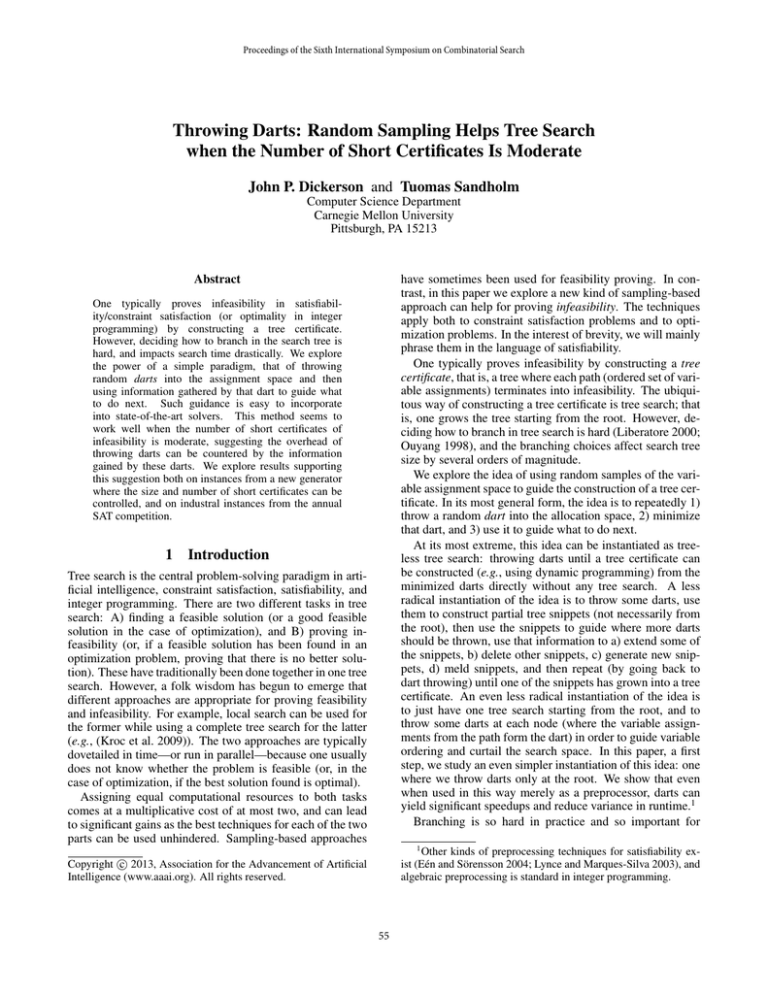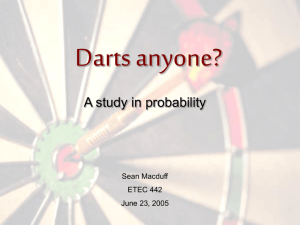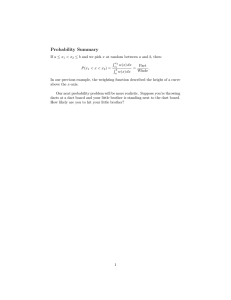
Proceedings of the Sixth International Symposium on Combinatorial Search
Throwing Darts: Random Sampling Helps Tree Search
when the Number of Short Certificates Is Moderate
John P. Dickerson and Tuomas Sandholm
Computer Science Department
Carnegie Mellon University
Pittsburgh, PA 15213
Abstract
have sometimes been used for feasibility proving. In contrast, in this paper we explore a new kind of sampling-based
approach can help for proving infeasibility. The techniques
apply both to constraint satisfaction problems and to optimization problems. In the interest of brevity, we will mainly
phrase them in the language of satisfiability.
One typically proves infeasibility by constructing a tree
certificate, that is, a tree where each path (ordered set of variable assignments) terminates into infeasibility. The ubiquitous way of constructing a tree certificate is tree search; that
is, one grows the tree starting from the root. However, deciding how to branch in tree search is hard (Liberatore 2000;
Ouyang 1998), and the branching choices affect search tree
size by several orders of magnitude.
We explore the idea of using random samples of the variable assignment space to guide the construction of a tree certificate. In its most general form, the idea is to repeatedly 1)
throw a random dart into the allocation space, 2) minimize
that dart, and 3) use it to guide what to do next.
At its most extreme, this idea can be instantiated as treeless tree search: throwing darts until a tree certificate can
be constructed (e.g., using dynamic programming) from the
minimized darts directly without any tree search. A less
radical instantiation of the idea is to throw some darts, use
them to construct partial tree snippets (not necessarily from
the root), then use the snippets to guide where more darts
should be thrown, use that information to a) extend some of
the snippets, b) delete other snippets, c) generate new snippets, d) meld snippets, and then repeat (by going back to
dart throwing) until one of the snippets has grown into a tree
certificate. An even less radical instantiation of the idea is
to just have one tree search starting from the root, and to
throw some darts at each node (where the variable assignments from the path form the dart) in order to guide variable
ordering and curtail the search space. In this paper, a first
step, we study an even simpler instantiation of this idea: one
where we throw darts only at the root. We show that even
when used in this way merely as a preprocessor, darts can
yield significant speedups and reduce variance in runtime.1
Branching is so hard in practice and so important for
One typically proves infeasibility in satisfiability/constraint satisfaction (or optimality in integer
programming) by constructing a tree certificate.
However, deciding how to branch in the search tree is
hard, and impacts search time drastically. We explore
the power of a simple paradigm, that of throwing
random darts into the assignment space and then
using information gathered by that dart to guide what
to do next. Such guidance is easy to incorporate
into state-of-the-art solvers. This method seems to
work well when the number of short certificates of
infeasibility is moderate, suggesting the overhead of
throwing darts can be countered by the information
gained by these darts. We explore results supporting
this suggestion both on instances from a new generator
where the size and number of short certificates can be
controlled, and on industral instances from the annual
SAT competition.
1
Introduction
Tree search is the central problem-solving paradigm in artificial intelligence, constraint satisfaction, satisfiability, and
integer programming. There are two different tasks in tree
search: A) finding a feasible solution (or a good feasible
solution in the case of optimization), and B) proving infeasibility (or, if a feasible solution has been found in an
optimization problem, proving that there is no better solution). These have traditionally been done together in one tree
search. However, a folk wisdom has begun to emerge that
different approaches are appropriate for proving feasibility
and infeasibility. For example, local search can be used for
the former while using a complete tree search for the latter
(e.g., (Kroc et al. 2009)). The two approaches are typically
dovetailed in time—or run in parallel—because one usually
does not know whether the problem is feasible (or, in the
case of optimization, if the best solution found is optimal).
Assigning equal computational resources to both tasks
comes at a multiplicative cost of at most two, and can lead
to significant gains as the best techniques for each of the two
parts can be used unhindered. Sampling-based approaches
1
Other kinds of preprocessing techniques for satisfiability exist (Eén and Sörensson 2004; Lynce and Marques-Silva 2003), and
algebraic preprocessing is standard in integer programming.
c 2013, Association for the Advancement of Artificial
Copyright Intelligence (www.aaai.org). All rights reserved.
55
runtime that all of the best complete satisfiability solvers
nowadays use random restarts (e.g., (Baptista and MarquesSilva 2000; Kautz et al. 2002; Huang 2007; Kilinc-Karzan,
Nemhauser, and Savelsbergh 2009)). If the run takes too
long, the search is restarted anew—while saving the clauses
learned via clause learning, which will be used to guide variable ordering and to curtail the search space in later runs.2
One could think of the search runs in random restarts as samples of the search space from which the algorithm learns.
However, in random restart approaches, unlucky variable ordering begets a huge search tree: in the search before the
next restart, all the samples are very similar because they
share all the variable assignments from the early part of the
search path. Darts are not as easily misguided by bad variable ordering because the next throw is not confined to having the same variable assignments as the early part of the
current search path. (Of course, both approaches are guided
to an extent by the nogoods learned so far.)
Another prior family of techniques that could be viewed
as a form of sampling is lookahead for determining which
variable to branch on, such as in strong branching, its variants like reliability branching (Achterberg, Koch, and Martin 2005), and entropic branching (Gilpin and Sandholm
2011). Those approaches are very different from ours because they typically only do 1-step lookahead, and only in
the context of the current search path.
The rest of the paper is organized as follows. Section 2
describes the general dart throwing framework. Section 2
provides a preliminary theoretical analysis of the framework
under strict assumptions. Section 3 describes experiments
performed on both generated and industrial instances from
the most recent SAT competition. Sections 4 and 5 respectively give conclusions and ideas for future research using
the darts framework.
2
after the dart has been minimized) can subsume the variable
assignments on the search path that is used to construct the
current dart. For contradiction, suppose there is a clause c in
the formula and that the search tree branch b used to throw
the current dart includes all the variable assignments of c
(and possibly also assignments of other variables). Then, at
some point in the branch b, it included all but one of the variable assignments in c. At that point, unit propagation would
have assigned to that last variable a value opposite of the
same variable’s value in c. Contradiction.
To minimize each new dart right after it has been constructed, any minimization routine can be used. We use the
minimization routine provided in MiniSat. After a dart has
been thrown and minimized, we add it to the satisfiability
formula that we are trying to prove unsatisfiable. Clearly,
it does not affect the satisfiability of the formula because it
is—like clauses added in clause learning—redundant. However, the added darts help guide variable ordering and prune
the search space by terminating search paths early.
Once the desired number of darts have been added, we
move from the dart throwing phase to the tree search phase,
which is done using the unchanged solver (MiniSat in our
case), but with the minimized darts now being part of the
formula. We call this approach Darts+DPLL. We are now
ready to begin the presentation of our study of the efficacy
of the dart-based approach.
A strong backdoor of a search problem is a set of variables that, regardless of truth assignment, give a simplified
problem that can be solved in polynomial time (Williams,
Gomes, and Selman 2003). Specifically, in DPLL-style
satisfiability, a strong backdoor of an unsatisfiable formula is a set of variables that, regardless of truth assignment, give a simplified formula that can be solved using
repeated unit propagation. Discovering a strong backdoor
is not easy; for instance, (Szeider 2005) discusses why
strong backdoor discovery using DPLL-style subsolvers is
intractable, while (Dilkina, Gomes, and Sabharwal 2007)
describes tradeoffs between search speed and capability. It
is well known that while pure random 3CNF formulas tend
to have large backdoors—roughly 30% of variables (Interian 2003)—real-world problems (e.g., logistics planning)
and structured artificial problems (e.g., blocks world planning) tend to have small strong backdoors (e.g., (Hoffmann,
Gomes, and Selman 2007)). Backdoor size has been shown
to correlate with problem hardness, at least with DPLL-style
search (Kilby et al. 2005).
A major motivation for our darts-based approach is that
we hope that darts will identify backdoors, and thereby help
in variable ordering, and ultimately lead to small search
trees. But do they indeed accomplish that efficiently? That
is the key question. For simplicity, we begin answering this
question by an analysis of a setting where we assume that
there exists what we coin a strict strong backdoor. A strict
strong backdoor is a strong backdoor where every variable
in the backdoor must be assigned before infeasibility of the
search path can be discovered by the search algorithm. This
differs from the standard notion of a strong backdoor, where
if the backdoor variables are set, infeasibility can be shown
Generating and Minimizing Each Dart
We use the underlying solver (MiniSat (Eén and Sörensson
2004) in the case of our experiments) to guide the construction of each dart. Each dart is in effect one search path from
the root to a node where infeasibility of the path can be detected. The path then constitutes a conflict clause.
For the construction of the path, we use uniform random
variable ordering. (This is only for darts throwing. For the
actual tree search that follows the dart throwing phase, we
let MiniSat use its own variable ordering heuristics.) However, we do employ repeated unit propagation using all the
clauses in the formula: both the original ones and any prior
minimized darts.
Proposition 2.1. The dart throwing framework will never
throw the same dart more than once, i.e., we are sampling
the assignment space without replacement.
Proof. We will show that no clause in the formula (and recall that all darts thrown so far are included in the formula
2
A completely different approach is to try to restructure the
search tree during the search (Glover and Tangedahl 1976; Ginsberg 1993; Ginsberg and McAllester 1994; Chvátal 1997; Hanafi
and Glover 2002; Zawadzki and Sandholm 2010).
56
quickly—but it may be possible to show infeasibility even if
some of the backdoor variables are not set.
eral generator of unsatisfiable formulas with easily controllable strong backdoor properties. We can control both the
size of the strong backdoor, as well as the expected number of unique strong backdoors. We study how the runtime
depends on the number of darts thrown and the number of
backdoors in a formula. Second, we provide results for industrial unsatisfiable instances used in the most recent SAT
competition3 . We show that the approach of throwing darts
followed by MiniSat (we call this approach Darts+DPLL)
sometimes results in a significant speedup while rarely resulting in a significant slowdown. We also show that throwing even a few dozen darts—a tiny portion of the expected
number of darts needed to discover a full backdoor—results,
surprisingly, in significant runtime changes.
Our experimental system was built on MiniSat 2.20 (Eén
and Sörensson 2004), a well-known and highly competitive DPLL-based SAT solver. We kept as much of the
original MiniSat solver unchanged as possible in order to
isolate the impact of darts. The unchanged parts include
MiniSat’s variable ordering heuristics, random restart methods, clause learning technique, subsumption checking, and
clause minimization technique. Our adjustments to the MiniSat system comprised only about 200 lines of code. We
ran all the experiments in parallel on the world’s largest
shared-memory supercomputer—with 4096 cores and 32TB
of shared memory—at the Pittsburgh Supercomputing Center.
We used MiniSat’s default parameter settings: Luby
restarts (-luby) with a base restart level of 100 (-rfirst)
and increase factor of 2 (-rinc), deep conflict clause minimization (-ccmin-mode), a clause activity decay factor of 0.999 and variable activity decay factor of 0.95
(-cla-decay, -var-decay), no random variable selection (-rnd-freq), and default garbage collection and
CPU/memory limits. These settings are those used by the
default MiniSat solver. All reported times include any overhead incurred from dart throwing and minimization.
Proposition 2.2. Let the unsatisfiable formula that needs to
be proven unsatisfiable have n variables. Let there be an
(unknown) strict strong backdoor of size k. Then, after 2k
darts have been thrown without replacement and minimized,
any tree search algorithm that branches only on variables
that occur in the minimized darts will find the shortest tree
certificate using a search tree of size at most 2k .
Proof. The construction of any dart will eventually terminate at a conflict. Furthermore, the learned clause corresponding to this conflict will get minimized to a clause containing only the variables in the k-backdoor. This is easy to
prove. First, if the minimized clause contains those k variables, it cannot contain any other variables because in that
case it would not be minimal (i.e., some variable could be
removed and the result would still be a conflict clause). Second, the minimized clause must contain all those k variables;
otherwise, infeasibility of the assignment would have been
proven without assigning all those k variables, which would
contradict the definition of a strict strong backdoor.
Proposition 2.1 proves that as a dart is constructed, it cannot have the same assignment vector to those k variables as
any previous dart. As there are only 2k assignments of the k
variables, all those assignments will be found with 2k darts.
Finally, any tree search algorithm that branches on variables in the minimized darts alone can only branch on at
most k variables because there are only k variables used
among the darts. Thus, the size of the search tree is at most
2k . Every search path terminates in a conflict because the
minimized darts act as the relevant conflict clauses.
The efficiency of this darts-based approach need not hinge
on the assumption of existence of a strict strong backdoor
(or even on the existence of a strong backdoor). However,
without that assumption the analysis would become much
more difficult due, at least, to the following reasons:
Random UNSAT Instances with Controllable Size
and Number of Strong Backdoors
• There can be any number of tree certificates, and they can
be of different sizes and of different tree shapes.
• The details of the dart minimization routine may affect
the analysis. The routine might return the same minimized dart for a large set of unminimized variable assignments. For some other minimized dart, there might
be only a small region of unminimized variable assignments that minimize to it. In fact, there can even be some
minimized darts (minimal conflict clauses) that the routine never outputs, starting from any (complete) variable
assignment.
For these experiments, we developed a generator of random
unsatisfiable formulas that allows easy control over the size
and expected number of strong backdoors. Having such
control is important because a generate-and-test approach
to creating instances with desirable numbers and sizes of
strong backdoors would be intractable. This is due to the
facts that finding a backdoor is difficult (Szeider 2005) and,
for many desired settings of the two parameters, the common instance generators extremely rarely create instances
with such parameter values (e.g., pure random 3CNF formulas tend to have large backdoors—roughly 30% of variables (Interian 2003)).
Our test suite consists of a set of graph coloring problems
that, while originally satisfiable, are tweaked to prevent feasibility. Our generator is a generalized version of that introduced in (Zawadzki and Sandholm 2010). We first ensure
that a randomly generated connected graph G = (V, E)
For these reasons, we opt to study the darts paradigm with
an extensive experimental section, where we cover a variety
of random and real-world problems of varying degrees of
difficulty. Through these experiments, we are able to discern
clear patterns regarding the efficacy of this new technique.
3
Experiments
In this section, we explore the effects of dart throwing on the
runtime of proving infeasibility. First, we introduce a gen-
3
57
http://www.satcompetition.org/
1.6 1.4 1.2 1 0.8 256 Darts 512 Darts 1024 Darts 0.6 0.4 0.2 0 5 10 15 20 25 30 35 40 45 50 55 60 65 70 75 80 85 90 95 100 Mean Speedup Factor is k-colorable. This is done via the canonical transformation of a graph coloring instance into a SAT instance (see,
e.g., (Van Gelder 2008)), followed by a satisfiability check
using MiniSat. Unsatisfiable instances are discarded so they
do not interfere with our control of the size and number of
backdoors discussed next. Then, a number n of (k + 1)cliques are introduced into the graph, with n proportional to
the desired number of short certificates. While not significantly changing the structure of the graph, no (k + 1)-clique
can be k-colored and thus this augmented graph cannot be
k-colored. So, the SAT formula is unsatisfiable.
A SAT solver can conclude infeasibility of such formulas
by reasoning only about the variables pertaining to a single
k + 1 vertex clique. In this way, we can control the size (k)
of a short certificate in the propositional formula as well as
the estimated number (n) of short certificates.4
Results. In the following experiments, we varied both
the cardinality of the formula’s set of short tree certificates
of infeasibility (i.e., number of cliques in the graph) and
the number of darts thrown. Experiments were performed
on these random, unsatisfiable graphs with |V | = 100 and
|E| = 1000, with the number of colors k = 10. Translating the augmented unsatisfiable coloring problem to propositional logic yielded CNF formulas with 900 variables and
between 12000 and 35000 clauses, depending on the number
of cliques added. For every parameter setting, 40 instances
(i.e., random graphs) were generated, and on each of them,
40 independent runs of the algorithm were conducted.
Figure 1 compares the solution times for a darts-based
strategy against that of pure MiniSat. Of particular note is
the significant speedup from darts in the “middle ground” of
75–95 cliques. We hypothesize that when there are very few
short certificates available, throwing darts will often result
such certificates being missed; thus, we realize little benefit
from darts. Conversely, when short certificates are ubiquitous (e.g., coloring a complete graph), DPLL is likely to find
such a certificate even without using darts. Another important aspect of dart throwing in these experiments is that it
never hurts the runtime much.
Figure 2 provides some insight into the hypothesis
given above by plotting the variance of the runtime of
Darts+DPLL relative to MiniSat. For a small number of
cliques, we see that throwing darts can actually increase
variance slightly; intuitively, if darts happen to find a short
certificate—however unlikely that may be—the overall runtime changes significantly. Similarly, when we have very
few cliques, throwing a larger number of darts increases the
variance more than a smaller number of darts, since there
is a higher chance of hitting one of the rare short certificates. Conversely, when short certificates are ubiquitous (at
and above 100 cliques), darts increase variance slightly due
to interactions between the random information provided by
darts and the structured pure MiniSat search. Most signif-
Number of Cliques Figure 1: Mean relative speed of throwing 10, 250, and 500
darts before running MiniSat versus running MiniSat without darts. Points above 1 correspond to the darts strategy
yielding a runtime improvement. There is a clear speedup in
the 75–95 cliques range.
icantly, however, Figure 2 shows that darts reduce variance
by an order of magnitude at 75–95 cliques. This suggests
that at a certain (relatively small) number of initial darts, we
are nearly guaranteed to find at least one short certificate,
thus dramatically reducing the variance.
Rela%ve Variance 10 1 10 Darts 250 Darts 500 Darts 0.1 0.01 10 20 30 40 50 60 70 80 90 100 Number of Cliques Figure 2: Log-scale runtime variance relative to a baseline of
1 provided by MiniSat without darts. Darts reduce the variance by an order of magnitude in the 75–95 cliques range.
More darts reduce the variance more.
Zooming in on the “Sweet Spot” for Darts. The experiments above show that the performance of the dart-based
strategy is tied to the number of short certificates in an unsatisfiable formula. When enough certificates exist to be found
with high probability by darts, but not so many as to guarantee discovery by MiniSat without darts, we see a significant
decrease in runtime and runtime variance. We now explore
the most promising part of that 75–95 clique range in detail.
Figure 3 shows the relative speedups across 10 different experimental settings—each of {86, 87, . . . , 94, 95} infeasible cliques—forming the upper half of the promising
range. Values above 1 represent a performance improvement over MiniSat without darts. To reduce uncertainty
in these graphs, for each of the 10 clique values, 20 random graphs (i.e., instances) were generated, and 20 different dart amounts (increasing roughly logarithmically from 0
to 25000) were thrown for each of those. All of this was repeated 40 times (i.e., 11·20·20·40 = 176000 runs were conducted). Regardless of number of cliques, throwing just 250
darts provides, in terms of both mean and median, a clear
decrease in runtime. Runtime monotonically decreases as
we add more darts until between 5000 and 7500 darts. Af-
4
The number of short certificates will not necessarily be exactly
n: two randomly placed cliques can overlap in such a way as to
create more than two cliques of the same size, given existing edges
in the graph G. For large enough V and relatively low numbers of
short certificates, we expect this to be rare and inconsequential.
58
35
Mean
Median
30
25
Relative Variance
Speedup Factor
ter that, the overhead of adding new clauses to the original
propositional formula (and the time spent on throwing and
minimizing the darts themselves) outweighs the benefit of
any information provided by the darts.
20
15
10
5
0
0
2
4
7
10
30
70
250 750 1500 2500
Number of Darts
4
3.5
3
2.5
2
1.5
1
0.5
0
0
2
4
7
10
30
70
250 750 1500 2500
Number of Darts
87 88 89 90 91 92 93 94 95 Figure 5: Mean and median runtime (left) and variance (right) relative to MiniSat without darts on the easy
hsat vc11813 instance. The maximum mean speedup
and the minimum relative variance occur at 70 darts.
1 5 40 150 2000 10000 20 75 500 5000 25000 0 30 100 1000 7500 10 50 250 2500 15000 5 40 150 2000 10000 20 75 500 5000 25000 0 30 100 1000 7500 10 50 250 2500 15000 0 5 40 150 2000 10000 0.5 0 30 100 1000 7500 Rela1ve Speed Number of Cliques 86 2 1.5 Number of Darts Thrown 87 88 89 90 91 92 93 94 95 1 often result in both a significant runtime boost and a significant decrease in runtime variance. Successful dart throwing
adds enough information to alleviate the variance introduced
by the heavy tail of these runtime distributions.
5 40 150 2000 10000 20 75 500 5000 25000 0 30 100 1000 7500 10 50 250 2500 15000 5 40 150 2000 10000 20 75 500 5000 25000 0 30 100 1000 7500 10 50 250 2500 15000 0 5 40 150 2000 10000 0.5 0 30 100 1000 7500 Rela1ve Speed Number of Cliques 86 2 1.5 Number of Darts Thrown Figure 3: Mean (top) and median (bottom) relative speed
of increasing numbers of darts (bottom axis) in each of
{86, 87, . . . , 95} cliques (top axis). The optimal number of
darts is in the 5000–7500 range.
Industrial UNSAT Instances
We now provide results for a number of unsatisfiable instances taken from industry. These real-world formulas were
taken from the international SAT competition’s Industrial
Track, and have served as benchmarks for dozens of stateof-the-art SAT solvers. The current SAT competition groups
instances as easy, medium, or hard; we provide results for
instances from each group. Each instance was run at least
25 times for each of 24 different numbers of darts (increasing roughly logarithmically from 0 to 25000 darts).
Case Studies. First, we present three case study success stories for the dart throwing paradigm. The first,
hsat vc11813, is currently ranked as easy while the second, total-5-13, is medium and third, AProVE07-27,
is hard. All three exhibit substantially different behavior,
and darts help significantly on them all.
Runtime and variance results for the hsat vc11813 instance are given in Figure 5. MiniSat solves this problem in
approximately 10 seconds. Relative mean speedup peaks at
just below 25x (slightly under 0.5 seconds), after 70 darts.
This peak correlates exactly with a decrease of between two
and three orders of magnitude in runtime variance. This
enormous speedup can be attributed to a particular behavior witnessed on some other easy instances as well: after
throwing enough darts, the space of legal solutions becomes
so constrained that the problem, given the extra clauses from
the darts, is trivially infeasible at the root of the search tree.
In the case of hsat vc11813, the average length (i.e.,
number of variables) of a dart was merely between 2 and 4.
Smaller darts carve out a large portion of the search space;
by throwing many of them, we whittle down the search space
to something that can be solved quickly given a few variable
assignments and unit propagation.
Figure 6 shows runtime and variance results for the
total-5-13 instance. On our test machine, MiniSat without darts solves this instance in approximately 95 seconds;
this aligns with the instance’s medium hardness ranking. After just 1–3 darts, the average runtime drops to just over 65
seconds—albeit with nearly three times the variance. With
just 20 darts, we maintain this speedup while simultaneously reducing variance compared to MiniSat without darts
Figure 4 studies how darts affect the variance in runtime.
Values below 1 represent a reduction in variance compared
to plain MiniSat. As in the broader case studied above, we
see that speed improvements from darts tend to correlate
with large decreases in variance. Our largest runtime improvements occurred at 5000–7500 darts; in that region the
variance was reduced by over an order of magnitude. This
suggests that throwing just a few thousand darts—with low
computational overhead—seems to cut off the heavy tail of
the runtime distribution, at least on these instances, better
than MiniSat’s tree search, which itself uses random restarts.
87 88 5 40 150 2000 10000 10 50 250 2500 15000 86 89 90 91 92 93 94 95 10 1 5 40 150 2000 10000 20 75 500 5000 25000 0 30 100 1000 7500 10 50 250 2500 15000 5 40 150 2000 10000 20 75 500 5000 25000 0 30 100 1000 7500 0.1 0.01 0 30 100 1000 7500 Rela1ve Variiance Number of Cliques 100 Number of Darts Thrown Figure 4: Log-scale runtime variance relative to a baseline
of 1 provided by MiniSat without darts. Note the common behavior across all numbers of cliques—when we see
a speedup from dart throwing, we also see a significant decrease in runtime variance.
Conclusions on the Random SAT Instances from
Graph Coloring. The experiments we presented so far suggest that a simple dart throwing strategy provides legitimate
benefit, both in terms of runtime and variance in runtime
across multiple runs, on formulas with a “medium” number of short certificates. With too few short certificates, dart
throwing can unluckily miss all of them, thus providing little
new information to the subsequent DPLL search. With too
many certificates, dart throwing provides redundant information to the tree search, resulting in little speedup. However, on instances in between these extremes, throwing even
a few hundred darts—at almost no computational cost—can
59
Relative Variance
Speedup Factor
1.8
1.6
1.4
1.2
1
0.8
0.6
0.4
0.2
0
Mean
Median
0
5
30
80
175
300
425
600
4.5
4
3.5
3
2.5
2
1.5
1
0.5
0
900 5000
0
5
30
80
Number of Darts
175
300
425
600
recommend, as future research, inclusion of a darts-based
strategy in a portfolio-based solver like SATzilla (Xu et al.
2008). By using an ensemble of different search techniques
and parameterizations of those techniques, a portfolio solver
could leverage the Darts+DPLL method only on instances
(like those detailed above) where a significant gain can be
achieved.
Conclusions on the Industrial SAT Instances. The behavior of the Darts+DPLL strategy on real-world, infeasible
industrial problems differs somewhat from that of our controlled test suite. Excitingly, while the graph coloring problems saw significant improvements in runtime up through
1000 or even 10000 darts, industrial instances generally required only a few dozen darts to realize the performance
change (on those instances that saw a runtime decrease). A
notable outlier occurred with the hard AProVE07-27 instance, where clause lengths remained constant and small
even as thousands of darts were thrown, resulting in a 60%
runtime improvement. This hints that darts thrown on this
hard instance continued to reveal large amounts of information about the search space; further exploration is required. Darts also caused the biggest changes in runtime
on the industrial instances, up to a median speedup of 30x
(on hsat vc11813 with 70 darts).
When darts decrease average runtime on an industrial instance, they also tend to decrease variance in runtime. When
darts increase runtime, they tend to fail gracefully (unless
time is wasted throwing thousands of darts), typically with
only a 10-15% runtime increase. However, one instance—
hsat vc11803—responded quite poorly to even just 250
darts. MiniSat without darts solves this instance in under
one second; throwing darts (and thus adding clauses into the
formula) merely adds overhead on this very easy instance.
900 5000
Number of Darts
Figure 6: Runtime (left) and variance (right) relative to MiniSat without darts on the medium hardness total-5-13
instance. There is a uniform speedup of approximately 50%,
corresponding to a roughly 50% drop in runtime variance.
Average Dart Length
Speedup Factor
1.8
Mean
Median
1.6
1.4
1.2
1
0.8
0.6
0.4
0
3
7
20
70
500
Number of Darts
1500
5000 25000
10
8
6
4
2
0
0
3
7
20
70
500
1500
5000 25000
Number of Darts
Figure 7: Mean and median runtime relative to MiniSat
without darts (left) and average dart length (right) on the
hard AProVE07-27 instance. Along with a roughly monotonic speedup, dart length remains quite low.
by about a factor of two.
Figure 7 shows both runtime and average dart length of
the hard AProVE07-27 instance. Dart length is measured
after the dart has been minimized, that is, after MiniSat’s
minimization procedure has been applied to the clause that is
the dart so as to obtain a minimal clause from it (i.e., a clause
from which no variable assignment cannot be removed while
keeping the clause a nogood). MiniSat solves this instance in
slightly over 3000 seconds. Unlike on many other instances,
adding tens of thousands of darts decreased runtime significantly. This is coupled with the darts’ average clause size
flattening out to a very low length of approximately 9, even
after 25000 were thrown. Typically, due to the paring down
of the full assignment space of variables, average lengths increase to a much longer length as more are thrown. Low
length darts slice off large portions of the assignment space;
in this instance, the constantly low length darts manage to
prune the assignment space, yielding a significant speedup.
4
Conclusions
In this paper, we explored a simple strategy that uses random sampling of the variable assignment space to guide the
construction of a tree certificate. This approach repeatedly
throws a dart into the assignment space and, after minimizing the resulting clause, uses this information to decide what
to do next (e.g., how to guide search, where to throw the next
darts). This can be used to find short certificates to satisfiability and constraint satisfaction problems, as well as prove
infeasibility in integer programming.
We showed that a simple dart throwing strategy, where
all darts are thrown before tree search begins, can easily
be incorporated into a state-of-the-art SAT solver, MiniSat.
In addition to darts helping guide its tree search, we were
able to make use of the solver’s fast mechanisms for guiding the construction of darts and for minimizing them. We
provided experimental results on both unsatisfiable industrial instances from the recent SAT competition, as well as
an instance generator that allows for easy control of the size
and number of short certificates in the generated formula.
Our results show that darts tend to increase solution speed
while decreasing runtime variance when the number of short
certificates in the formula is neither extremely small nor extremely large. From this, we conclude that darts are an effective way to curtail the heavy tail of certain runtime distri-
Overall Results. We now present and discuss results of
running the Darts+DPLL strategy on a wide variety of infeasible problem classes taken from the most recent international SAT competition. Figure 8 shows these results for
10, 250, and 2500 darts; we found that these three amounts
were typically indicative of the overall performance (up to a
maximum of 25000 darts tested).
Overall, these aggregate results show that, while in some
cases dart throwing from the root node alone can help (significantly), the strategy alone is not a panacea. Our overall results show that darts tend to increase solution speed
while decreasing runtime variance when the number of short
certificates in the formula is neither extremely small nor
extremely large; intuitively, some industrial instances, especially those found in the SAT competition, fall to either end of this extreme. It is with this in mind that we
60
Darts Thrown
Instance
total-10-13-u
total-5-11-u
total-5-13-u
uts-l05-ipc5-h26-unsat
uts-l05-ipc5-h27-unknown
uts-l06-ipc5-h28-unknown
uts-l06-ipc5-h31-unknown
uts-l06-ipc5-h33-unknown
hsat vc11803
hsat vc11813
q query 3 l44 lambda
q query 3 l45 lambda
q query 3 l46 lambda
q query 3 l47 lambda
q query 3 l48 lambda
gus-md5-04
gus-md5-05
gus-md5-06
gus-md5-07
gus-md5-09
eq.atree.braun.10.unsat
eq.atree.braun.8.unsat
eq.atree.braun.9.unsat
AProVE07-8
AProVE07-27
countbitsrotate016
countbitssrl016
countbitswegner064
icbrt1 32
minand128
Mean
1.047
0.683
1.310
0.931
1.167
0.848
1.174
0.824
0.878
2.423
0.828
0.814
0.826
1.107
0.793
1.211
0.765
0.973
1.064
1.100
1.107
0.900
0.985
0.715
1.019
1.221
0.833
0.839
0.982
1.081
Unsatisfiable Industrial Instances
10
250
Median
Var.
Mean Median
1.155
4.344
0.943
1.091
0.728
3.534
0.674
0.739
1.462
0.524
1.288
1.439
0.883
0.264
0.884
0.814
1.112
0.820
1.113
1.072
0.791
2.000
0.996
0.796
1.100
0.343
1.189
1.094
0.784
1.351
0.823
0.822
0.876
2.305
0.304
0.293
1.952
11.703 14.773 14.379
0.861
2.112
0.807
0.830
0.8323
2.000
0.786
0.810
0.721
2.342
0.807
0.732
1.151
1.849
1.106
1.088
0.825
2.288
0.795
0.868
1.290
1.274
0.816
0.931
0.978
5.418
0.629
0.686
0.945
0.587
0.859
0.875
1.045
0.395
1.008
0.937
1.026
0.341
1.033
0.927
1.220
987.8
1.143
1.223
0.891
5.755
0.867
0.852
0.972
22.87
0.881
0.887
0.734
1822
0.560
0.515
0.979
8.890
0.920
0.981
1.264
11.39
1.067
1.050
0.920
10.15
0.587
0.592
0.893
33.92
0.760
0.743
1.007
1.248
0.990
1.000
1.005
0.997
1.198
1.163
Var.
8.814
4.772
0.925
0.332
0.793
1.176
0.245
1.249
18.775
0.014
1.714
1.728
3.888
1.064
1.636
2.329
6.101
0.655
0.364
0.492
398.6
5.447
22.16
966.7
20.12
3.065
15.82
51.67
3.712
2.375
Mean
0.971
0.410
1.138
0.950
1.371
1.194
1.345
0.817
0.048
2.523
0.817
0.734
0.788
1.102
0.803
0.090
0.142
0.299
0.483
0.773
1.003
0.665
0.765
0.670
1.208
1.395
0.445
0.591
1.149
0.939
2500
Median
1.097
0.423
1.215
0.987
1.364
1.209
1.282
0.789
0.052
2.686
0.812
0.782
0.804
1.091
0.780
0.073
0.132
0.251
0.430
0.634
1.143
0.624
0.778
0.758
1.169
1.445
0.488
0.628
1.240
0.982
Var.
7.947
11.670
0.554
0.354
0.660
1.632
0.565
2.672
3299
2.236
0.774
2.462
2.625
1.799
1.158
216.9
88.49
11.66
4.037
0.635
708.5
22.51
41.47
3706
19.767
13.25
21.59
496.8
8.800
2.866
Figure 8: Mean, median, and variance of runtime relative to Minisat without darts, for 10, 250, and 2500 darts. Unsatisfiable
industrial instances are grouped by problem type, and were drawn from the most recent industrial SAT competition.
butions. In random restarting, unlucky variable ordering not
only creates a huge search tree, but also confines all samples of variable assignments to being paths in that poor tree.
In contrast, our sampling is not misguided by bad variable
ordering. The experiments show the benefits of this.
5
Gomes, Selman and Kautz (1998))—it would be interesting
to see how the added information from darts affects runtime
speed and variance.
A dart-based strategy would be a particularly appropriate
candidate for inclusion in a portfolio-based solver, (e.g., in
the satisfiability world, SATzilla (Xu et al. 2008)). When
darts work, they tend to work quite well; however, there are
some industrial instances that do not realize a runtime benefit. Inclusion in a portfolio of algorithms would help utilize
the various wins of a dart-based strategy, while providing
further information regarding when darts work, and how this
general paradigm could be augmented.
Future Research
A clear direction for future research is to expand the basic
darts throwing strategy used in the experimental section of
this paper to a more informed strategy, like those discussed
in the introduction. For example, an interesting direction
for future research would be to use darts as a semi-random
restart strategy during tree search. Since, if darts work, they
tend to work with very low variability and high speedup, one
could throw a small number of darts—with low overhead—
and then restart the subsequent tree search after a small time
period if the dart throws did not yield immediate improvement. Combined with one of the standard randomized restart
strategies—which have been shown to yield multiple orders of magnitude speedup on heavy-tail distributions (e.g.,
One should study the more radical dart-based approaches
offered in the introduction beyond throwing darts at the root
of a search tree, possibly in conjunction with similar ideas by
Richards and Richards (2000). Also, one could explore using darts in other proof systems beyond DPLL (e.g., (Beame
et al. 2010; Hertel et al. 2008)).
61
References
Ouyang, M. 1998. How good are branching rules in DPLL? Discrete Applied Mathematics 89(1-3):281–286.
Richards, E., and Richards, B. 2000. Nonsystematic search and nogood learning. Journal of Automated Reasoning 24(4):483–533.
Szeider, S. 2005. Backdoor sets for dll subsolvers. Journal of
Automated Reasoning 35:73–88.
Van Gelder, A. 2008. Another look at graph coloring via propositional satisfiability. Discrete Applied Math. 156(2):230–243.
Williams, R.; Gomes, C.; and Selman, B. 2003. Backdoors to
typical case complexity. In IJCAI, volume 18, 1173–1178.
Xu, L.; Hutter, F.; Hoos, H.; and Leyton-Brown, K. 2008. Satzilla:
portfolio-based algorithm selection for SAT. Journal of Artificial
Intelligence Research 32(1):565–606.
Zawadzki, E., and Sandholm, T. 2010. Search tree restructuring.
Technical Report CMU-CS-10-102, Carnegie Mellon University.
Achterberg, T.; Koch, T.; and Martin, A. 2005. Branching rules
revisited. Operations Research Letters 33(1):42–54.
Baptista, L., and Marques-Silva, J. 2000. Using randomization
and learning to solve hard real-world instances of satisfiability. In
International Conference on Principles and Practice of Constraint
Programming (CP), 489–494.
Beame, P.; Impagliazzo, R.; Pitassi, T.; and Segerlind, N. 2010.
Formula caching in DPLL. ACM Transactions on Computation
Theory 1.
Chvátal, V. 1997. Resolution search. Discrete Applied Mathematics 73(1):81–99.
Dilkina, B.; Gomes, C.; and Sabharwal, A. 2007. Tradeoffs in the
complexity of backdoor detection. In CP, 256–270. Springer.
Eén, N., and Sörensson, N. 2004. An extensible SAT-solver. In
SAT, 333–336.
Gilpin, A., and Sandholm, T. 2011. Information-theoretic approaches to branching in search. Discrete Optimization 8:147–159.
Early version in IJCAI-07.
Ginsberg, M., and McAllester, D. 1994. GSAT and dynamic backtracking. Lecture Notes in Computer Science 243–243.
Ginsberg, M. 1993. Dynamic Backtracking. Journal of Artificial
Intelligence Research 1:25–46.
Glover, F., and Tangedahl, L. 1976. Dynamic strategies for branch
and bound. Omega 4(5):571–576.
Gomes, C.; Selman, B.; and Kautz, H. 1998. Boosting combinatorial search through randomization. In Proceedings of the National
Conference on Artificial Intelligence (AAAI).
Hanafi, S., and Glover, F. 2002. Resolution search and dynamic branch-and-bound. Journal of Combinatorial Optimization
6(4):401–423.
Hertel, P.; Bacchus, F.; Pitassi, T.; and Gelder, A. V. 2008. Clause
learning can effectively p-simulate general propositional resolution. In Proceedings of the National Conference on Artificial Intelligence (AAAI), 283–290.
Hoffmann, J.; Gomes, C.; and Selman, B. 2007. Structure and
problem hardness: Goal asymmetry and DPLL proofs in SATbased planning. Logical Methods in Computer Science 3(1):6.
Huang, J. 2007. The effect of restarts on the efficiency of clause
learning. In IJCAI, 2318–2323.
Interian, Y. 2003. Backdoor sets for random 3-SAT. SAT 231–238.
Kautz, H.; Horvitz, E.; Ruan, Y.; Gomes, C.; and Selman, B. 2002.
Dynamic restart policies. In AAAI, 674–681.
Kilby, P.; Slaney, J.; Thiébaux, S.; and Walsh, T. 2005. Backbones
and backdoors in satisfiability. In Proceedings of the National Conference on Artificial Intelligence (AAAI), 1368.
Kilinc-Karzan, F.; Nemhauser, G.; and Savelsbergh, M. 2009.
Information-Based Branching Schemes for Binary Linear Mixed
Integer Problems.
Mathematical Programming Computation
1(4):249–293.
Kroc, L.; Sabharwal, A.; Gomes, C.; and Selman, B. 2009. Integrating systematic and local search paradigms: A new strategy for
MaxSAT. IJCAI.
Liberatore, P. 2000. On the complexity of choosing the branching
literal in DPLL. Artificial Intelligence 116(1-2):315–326.
Lynce, I., and Marques-Silva, J. 2003. Probing-based preprocessing techniques for propositional satisfiability. In 15th IEEE International Conference on Tools with Artificial Intelligence, 105–110.
IEEE.
62








